Top Links
Journal of Forensic Science & Criminology
ISSN: 2348-9804
Development of Fingerprint on Different Surface by Non-Conventional Method
Copyright: © 2021 Ariff S. This is an open-access article distributed under the terms of the Creative Commons Attribution License, which permits unrestricted use, distribution, and reproduction in any medium, provided the original author and source are credited.
Related article at Pubmed, Google Scholar
Fingerprint acts as a prime evidence to provide person identification as well as it has vast applications in criminal investigation. Fingerprint plays a very important role in today’s scenario. Majority will use physical powder method, chemical method for development of latent prints. But due to toxic in nature, less availability, and high price, we tried to develop the prints with non-conventional powders (baking powder, talcum powder, fuller’s earth, turmeric powder and vermilion). Because these non-conventional household powders are easily available. We used these powders on different non-porous surface and semi-porous surface for development of latent fingerprints. The development of fingerprint depends on the different factors like fineness of powder, adherence property of powder and the pigmentation of powder should be in contrast with surface for visibility of fingerprints. This method is properly toxic free and eco-friendly. We didn’t use any kind of binder with household powders. Among all the powders, we chose non – conventional powder and got best result with baking powder, as it showing proper and clear ridge details. In future, we can use the above-mentioned household powders as an alternative of laboratory powders. Among all the surfaces, we got best result in glass surface with all the powders.
Keywords:Latent Fingerprint; Non-Conventional Powder; Non-Porous Surface; Semi-Porous Surface; Ridges
Fingerprints are individual characteristics present on each and everyone’s finger in the form of the friction ridges which consist of different pattern like Arches, Loops, Whorls. Arches are wave like patterns. There are two types of arches;
• Plain arches: these are in straight line formation. • Tented arches: these are rise to a sharp spike in the centre. Loops: In a loop pattern of fingerprint the ridges start from one side and then form a curve which end at same side is known as loops. There are two types of loops; • Radial loops: Ridges moves towards the radial bone or thumb. • Ulna loops: Ridges moves towards ulna bone or little finger. Whorls: These are whirlpools like pattern consist of circular or spiral pattern. There are four types of whorls pattern; • Plain whorl: these are concentric circles. • Central pocket loop: it is a loop with a whorl at end. • Double loop: consist of two loops which makes-like patterns. • Accidental loops: these are just some irregular shapes/figures.
These fingerprint patterns consist of Delta and Core. Delta: a triangular point in loops and whorl pattern of fingerprint from which ridge counting get started. Core is the centre and innermost part of the pattern. Fingerprint pattern consists of different kind of ridge characteristics like Bifurcation, Trifurcation, Mountain, Dots and many others. These ridge characteristics are totally different in each and every person and even in those who have same fingerprint pattern. As compare to DNA fingerprint, fingerprint identification method is considered more reliable because the monozygotic twins have same sequence of DNA pattern but have different fingerprint (uniqueness) [1]. The reason behind the different fingerprint is during the pregnancy the blood pressure of mother fluctuates a lot which creates different pressure on fetus and the transfer of nutrition to the babies through placenta is different.
There is no exact evidence but it is considered that the formation of fingerprint is started around the three month of fetal development and fully developed around 6th month and remain same throughout the life. The fingerprints are transferred to the surface when the sweat released from the pores of friction ridges get deposited on the surface which create a replica or mirror image of ridge pattern [2].
Types of fingerprint: three types of fingerprints are latent fingerprint, patent fingerprint and plastic prints.
Latent fingerprint: these are the prints which form when the sweat from pores of friction ridges deposit on the surface. Theses prints are not visible to the naked eyes. So, we have to use powders, chemicals or an alternate light method for visibility. Latent fingerprint residue consists of secretion of eccrine, sebaceous, and apocrine gland present on palm. Sweat contains water (>98%), minerals (0.5%), and organic components (0.5%) [3]. Patent prints: the print which we can see with the naked eyes. For example; fingerprint in surface of blood, prints in ink, flour etc. Plastic prints: these are 3- dimensional impressions when a finger pressed with pressure on a soft surface (wax, fresh paint etc.) create a cast like prints which is visible to naked eyes and does not need any development methods.
Types of surfaces; there are three types of surfaces i.e., porous, non – porous and semi – porous surface. Porous surfaces are those which consist of small pores that allows penetration of external materials like water, air, particles into the pores. For examples: untreated wood, fabrics, cardboard etc. Non- porous surfaces are smooth surface which does not consist any pores. Examples: polished wood, glass, plastic etc. And semi – porous surfaces are water soluble surface like waxed surface, glossy finish, varnished wood etc. [4].
Currently expert are using powders like grey powder, white powder and black powder as a physical method of development of fingerprints. Powder consists of two components; Pigments which helps to give color to powder. And binders which are helpful in adherence of the powder with sweat content of fingerprint. There are various properties which make a powder eligible for development of prints. Stated below; the powder should have fine particles, binding property of powder with the sweat content of print, they should show the property of crystallization. Temperature and humidity are most important property which affect the visibility and development of fingerprint. All the experiments are carried out in the month of February and March when temperature fluctuating from 17 to 32 degree centigrade and humidity range varied from 63 to 94 percent [5]. In case of high temperature in summer we cannot use table salts as a powder for fingerprint development at room temperature as due to high humidity there is a hydration of table salts.
Chemical methods are used in various kind of cases like enhancement of residual blood contain fingerprint. Chemical methods are like Ninhydrin, Iodine fuming method and many others. In chemical methods the main compound of the chemical is react with amino acid of fingerprint and gives result. But method can cause destruction or damage to our health like in iodine fuming method the chemical compound release some kind of harmful toxic fumes which is not good for health. Secondly these chemical method are not that cheap and availability of chemicals are not that much convenient.
• Turmeric powder (Curcuma longa): turmeric is a rhizomatous herbaceous perennial plant, and belongs to ginger family Zingiberaceae [6]. The rhizomes which yield turmeric are short thick with blunt tubers. It consists essentially of coloring principles 1,7-bis-(4-hydroxy-3-methoxy-phenyl)-hepta-1,6-diene-3,5-dione, and also known as curcumin. It can exist in two tautomeric forms, i.e., keto and enol. Functional use of curcumin as a food additive is color.
• Fuller’s earth (Multani mitti): also known as bleaching clay. It is composed of hydrous aluminum silicate in varying composition. Small amount of minerals is also present those are calcite, dolomite, montmorillonitre and quartz. In some places fullers earth refers to calcium bentonite because it resembles with calcium – montmorillonite in its chemical and physical properties. Fuller's earth is more fine compare to other soils that’s why it gives better result as compare to other soil in fingerprint development.
• Baking powder: sodium bicarbonate (Na2CO3) commonly known as baking soda. Sodium bicarbonate is a mixture of carbon, sodium, hydrogen, and oxygen. It’s a white crystalline powder. It easily soluble with water and release carbon dioxide as bubbles form, this process is known as decomposition reaction. It is very fine in nature that’s why we used this powder for fingerprint development.
• Talcum powder: talcum powder is a naturally occurring mineral and used in everyday products such as baby powder, cosmetics etc. Talcum powder composed of hydrous magnesium silicate and is comprised of magnesium, silicon, oxygen and hydrogen. Talcum powder is very fine and it has property to absorb moisture that’s why it helps in to absorbing moisture or sweat content in latent fingerprint for visualization of ridge details [7].
• Vermilion powder: commonly known as sindoor. Vermilion is red lead and contains mercury. Different textures of vermilion are found in different places for example; the vermilion used in west Bengal is finer like gulal. And in some places like Bihar, Chhattisgarh, Uttar Pradesh, the texture of vermilion is not so fine or it is thicker.
In the present study, five different types of powders are used i.e. talcum, baking, turmeric, fuller's earth and vermilion.
For Turmeric powder: We had taken dried turmeric and then we used pestle and mortar. latter turmeric was converted into fine powders then we used sieve plate as separation method and then fine particles of turmeric powder are used for development of fingerprint.
Brush - Fingerprint Brush.
Twenty samples were collected in total from four different surfaces with each five powders by the five members.
We have collected 16 female samples and 4 male samples. The male age group ranges from (40-50 years) and female group ranges from (20-50 years). All male samples are collected from working persons and only one female sample is working one. The work does not include the factors like, age, gender and occupation.
Development of fingerprint: We developed fingerprint on surfaces by rubbing finger on hair, near to nose, behind the ears, so that sweat can develop in our fingers and that can transfer to surfaces.
For visualization of collected prints we used two methods;
For Non- porous surfaces like plastic, wood, glass surfaces, we used brush for development and powders for visualization.
For semi - porous surface like paper, we used rolling method for development and powder for visualization.
Pinch of powder was taken in brush and distributed nearby area of print with a slow and smooth hand along the ridges either in clockwise or in anti-clockwise direction. Brush was moved so that no ridges can break. When the same step was used in porous surface i.e., paper then development of fingerprint is there but ridges broke due to weak adhesive force between paper and powder. So, we used second method i.e., roll method. In this we took little more powder, and then we have to move paper like waves and then the powder will stick to the print.
We will take pictures before lifting to preserve the nature and character of latent fingerprint, also to avoid any kind of accidental disturbance while lifting.
• Should not use very much powder. • Avoid to open the things after use. • Take a photograph before lifting the prints. • Marking should be done accurately. • Avoid lifting process as much as possible.
Results of the development of fingerprint with household powder are totally depended upon the some of the characteristics like mainly type of the surface (whether it’s porous or non-porous), adherence of household powder with the moisture content of the sweat, color of the powder, color of surface, fineness of powder, and many other. Here we took 5 household powders, these are: -
• Baking Powder • Talcum Powder • Vermilion Powder • Turmeric Powder • Fuller’s earth Powder
Surfaces:- Glass surface, Plastic surface, Polished wood surface and Paper (we used chart paper and normal paper. We used normal paper for turmeric and vermillion and we used chart paper for fuller’s earth, talcum or baking powder).
• On non-porous surfaces; baking powder adheres perfectly with the non- porous surfaces (Glass, Plastic and polished wood) and gives a very clear result with maximum clarity in ridges. On the surfaces which are light in color we can use blue light torch for visibility (Eric H. Holder, Jr. et al., 2012) [8]. • On Semi-porous surface (Paper) results are not given by using rolling method.
Talcum powder gives results with all the non-porous surfaces (Polished wood, Glass and plastic) and partially with semi porous surface as it only develops half of print and this was done with rolling method.
• Vermilion also known as sindoor, gives result with non-porous surfaces like polished multicolor wood, glass and plastic with clearly seen ridge details. • On semi porous surface (paper), print is visible but the ridges are not that clearly visible and this is done by rolling method.
• Turmeric powder is yellow pigmented spice used for everyday cooking purpose in household. The turmeric in non-porous surface like glass is showing the results but due to excess fine texture, powder sticks on print. On plastic it shows the location but details are missed from prints. On metal steel it is showing clear result with ridge details. • On semi porous surface (Paper) with rolling method, print is visible but ridge details are missing.
• Fuller’s earth also known as Multani mitti, is an Indian beauty product. The results of fuller’s earth are quite good on non-porous surface like glass and plastic with clearly seen ridge detail but in case of polished multi color wood the result is not visible. • In semi porous surface (paper) there is no result. (similar result as Pallavi Thakuret al., 2016)
Non - Conventional powder (household powders) are used in this study for the development of latent fingerprint as it is less toxic, easy availability and less expensive, also these are easily available in home.
In this study we had taken common surface which are very common in most of the cases that are wood, plastic, glass and paper.
According to us we got the best results with talcum powder, baking powder and fuller’s earth, as these powders give proper ridge details on most of non-porous surface and got the similar results for fuller earth by (Aayush Dhunna et al., 2018) [9]. New visualization agent to reveal the hidden secret of latent fingerprints. Egypt J Forensic science 32(2018). We got best results on semi-porous surface (paper) with turmeric where we use rolling method for development of print. Baking powder results on paper are totally depended upon the type of paper surface, just like it will give different results on chart paper, whereas it gives different results on currency note as mention in (Richa Rohatgi et al., 2014) [10].
These methods have some limitations also; (1) the results are depending on the quality of surface like even the surface are of same nature (non-porous and semi-porous) still the results can be different. for example: – Baking powder gives very good results on polished multicolor wood surface but same didn’t give results with polished black surface (Similar result as Jaskirandeep et al., 2015) [11], so we can say that dependency of results can also rely on the quality, constitution of polished (drying oil, wax, varnish) type of paint and number of coats of paint and ability to cover the porosity of surfaces. If the quality of paint and polish are poor then it will not be able to cover the porosity of surface even if the surface is polished. And we took it as non – porous but due to poor quality of contents the powders start deposited into the pores of surface and results are not showing details and properly.
(2) In some cases, due to difference in fineness, particle size and pigments, the results can be different as difference in fineness of powders, adherence can be differed on surface of same nature for example; in case of turmeric and vermilion, the pigment and texture of powder is different in different parts of country. As in some houses the turmeric roots are finely crust and some used the turmeric which are available in market which consists of other AZO compound like Sudan dye and metanil yellow. And sometimes other spice powders are also used to improve the color. Whereas in home grown turmeric powder, the turmeric is only the component and fineness of powder differs in each household. As we talk about the vermilion powder, its texture and color are different in different places like in some stales the vermilion is of orange color, in some places it maroon, somewhere its crimson red and talking about texture someplace it is more like chalky texture.
So, for treating these problems we have to either crust the powder more to make it in fine texture. And we can separate the fine particles from the larger particles by using sieve.
In this paper we studied about non-conventional powder for the development of latent fingerprint in non-porous and semi-porous surfaces. And we concluded that baking powder gives better result of ridge details. Furthermore, talcum and fullers earth give good results in maximum surfaces. We also concluded that these powders can be used as alternative of laboratory powders too. We concluded that small amount of these powders can develop latent fingerprint. These powders are easily available, less toxic and less expensive. In future these powders can be used to work in field.
|
Turmeric powder |
Baking powder |
Talcum powder |
Fuller’s Earth |
Vermillion powder |
Glass surface |
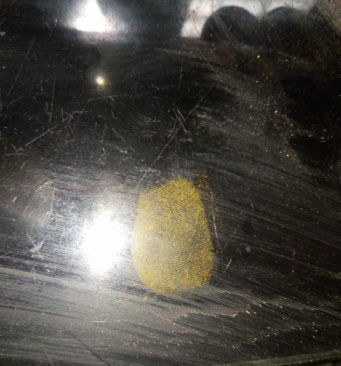 |
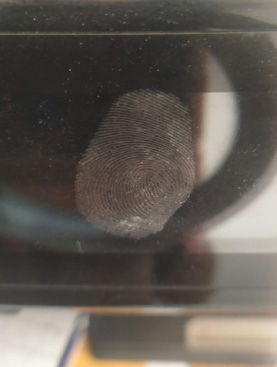 |
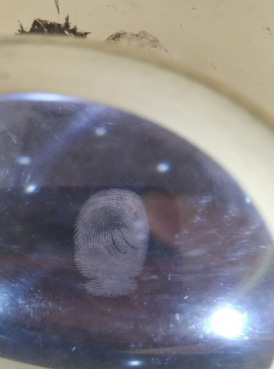 |
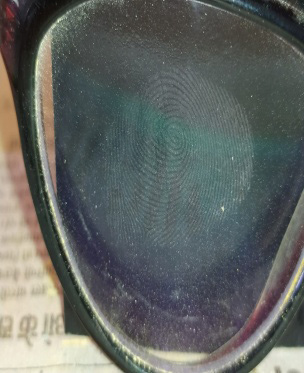 |
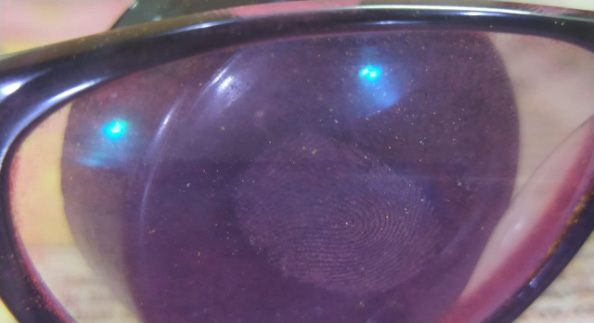 |
Plastic surface |
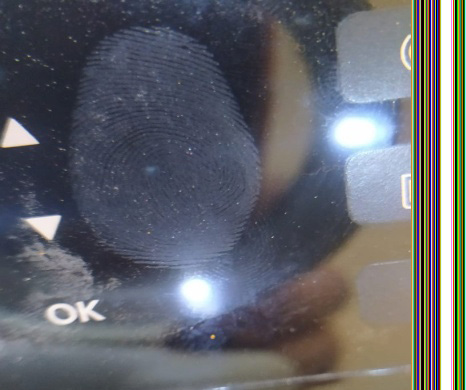 |
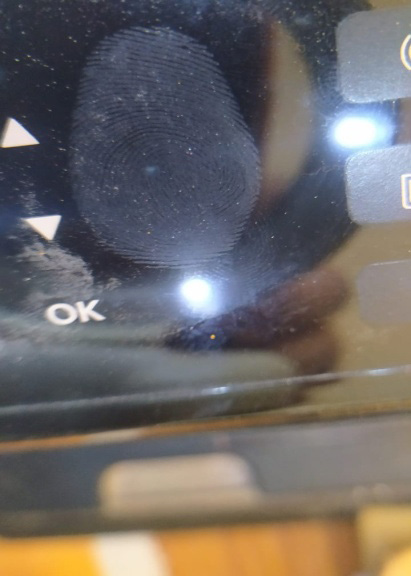 |
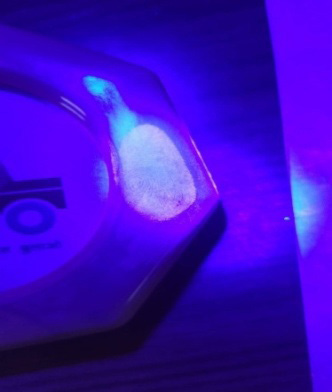 |
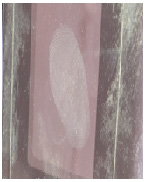 |
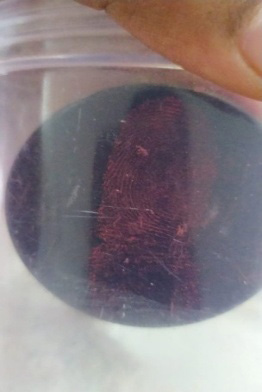 |
Polished wood surface |
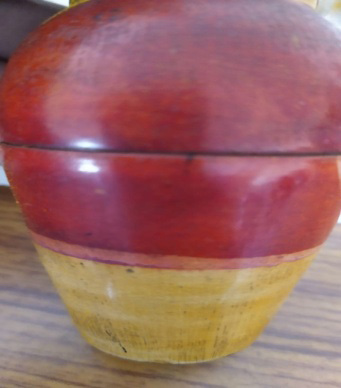 |
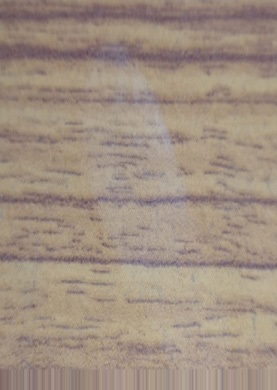 |
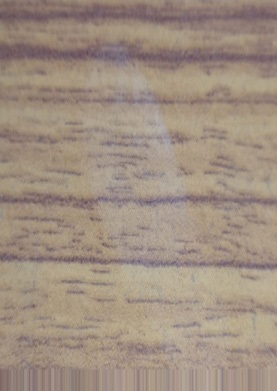 |
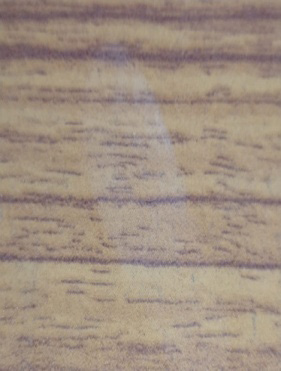 |
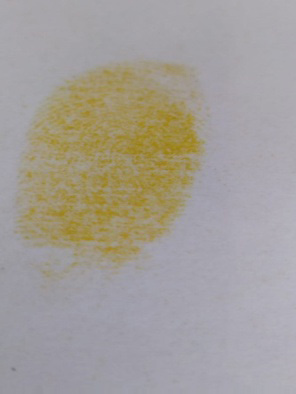 |
Paper surface |
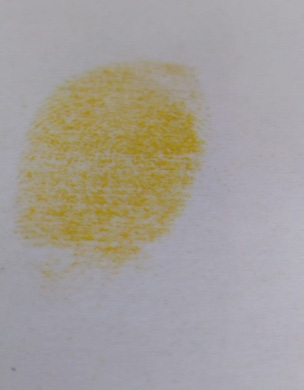 |
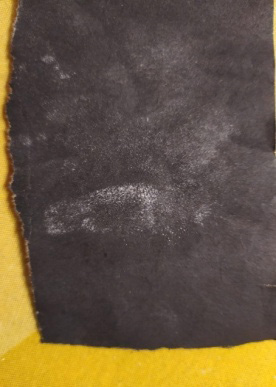 |
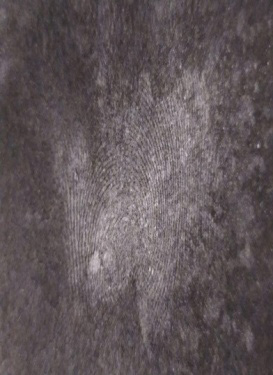 |
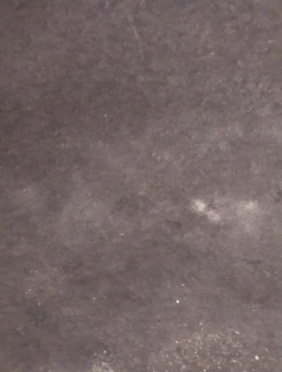 |
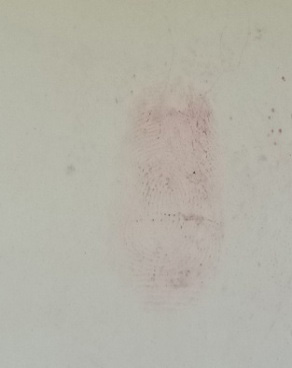 |
OUR RESULTS |
OTHERS RESULTS |
In our case we get results in glass surface, the results are showing clearly but some details are missing. We don’t get results for plastic and pol- ished wood. In semi-porous surface (paper), there is a visibility of sample but still details are missing. |
Vaibhav Saran, 2015 [4] |
In our case we get results on all non-porous sur- face (glass, plastic, polished wood and paper), we got maximum clarity and visibility of sample with perfect ridge details. Whereas in case of non-po- rous surface (paper) results are not seen. |
Richa Rohatgi, 2014 [10] |
In our case we get results on all non porous sur- face (glass, plastic, polished wood and paper), we got maximum clarity and visibility with perfect ridge details. In case of semi-porous surface (pa- per) the print is partially (half) develop. |
Kriti Nigam, 2021 [7] |
In our case we get visible result on glass surface and on plastic surface the results are visible but minute details are missing. Whereas in polished wood surface and paper surface the results are not seen. |
Pallavi Thakur, 2016 [12] |
In our case we get good results in polished wood, glass and plastic surface but in semi-porous sur- face (paper) we get print but we missed ridge de- tails. |
Amit Chauhan, 2017 [1] |





































